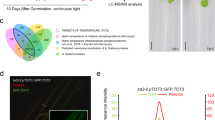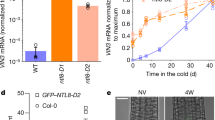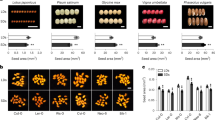Abstract
Plant growth and development are strongly affected by small differences in temperature1. Current climate change has already altered global plant phenology and distribution2,3, and projected increases in temperature pose a significant challenge to agriculture4. Despite the important role of temperature on plant development, the underlying pathways are unknown. It has previously been shown that thermal acceleration of flowering is dependent on the florigen, FLOWERING LOCUS T (FT)5,6. How this occurs is, however, not understood, because the major pathway known to upregulate FT, the photoperiod pathway, is not required for thermal acceleration of flowering6. Here we demonstrate a direct mechanism by which increasing temperature causes the bHLH transcription factor PHYTOCHROME INTERACTING FACTOR4 (PIF4) to activate FT. Our findings provide a new understanding of how plants control their timing of reproduction in response to temperature. Flowering time is an important trait in crops as well as affecting the life cycles of pollinator species. A molecular understanding of how temperature affects flowering will be important for mitigating the effects of climate change.
This is a preview of subscription content, access via your institution
Access options
Subscribe to this journal
Receive 51 print issues and online access
$199.00 per year
only $3.90 per issue
Buy this article
- Purchase on Springer Link
- Instant access to full article PDF
Prices may be subject to local taxes which are calculated during checkout




Similar content being viewed by others
References
Samach, A. & Wigge, P. A. Ambient temperature perception in plants. Curr. Opin. Plant Biol. 8, 483–486 (2005)
Fitter, A. H. & Fitter, R. S. Rapid changes in flowering time in British plants. Science 296, 1689–1691 (2002)
Willis, C. G., Ruhfel, B., Primack, R. B., Miller-Rushing, A. J. & Davis, C. C. Phylogenetic patterns of species loss in Thoreau’s woods are driven by climate change. Proc. Natl Acad. Sci. USA 105, 17029–17033 (2008)
Battisti, D. S. & Naylor, R. L. Historical warnings of future food insecurity with unprecedented seasonal heat. Science 323, 240–244 (2009)
Halliday, K. J., Salter, M. G., Thingnaes, E. & Whitelam, G. C. Phytochrome control of flowering is temperature sensitive and correlates with expression of the floral integrator FT. Plant J. 33, 875–885 (2003)
Balasubramanian, S., Sureshkumar, S., Lempe, J. & Weigel, D. Potent induction of Arabidopsis thaliana flowering by elevated growth temperature. PLoS Genet. 2, e106 (2006)
Blazquez, M. A., Ahn, J. H. & Weigel, D. A thermosensory pathway controlling flowering time in Arabidopsis thaliana. Nature Genet. 33, 168–171 (2003)
Koini, M. A. et al. High temperature-mediated adaptations in plant architecture require the bHLH transcription factor PIF4. Curr. Biol. 19, 408–413 (2009)
Stavang, J. A. et al. Hormonal regulation of temperature-induced growth in Arabidopsis. Plant J. 60, 589–601 (2009)
Nozue, K. et al. Rhythmic growth explained by coincidence between internal and external cues. Nature 448, 358–361 (2007)
Valverde, F. et al. Photoreceptor regulation of CONSTANS protein in photoperiodic flowering. Science 303, 1003–1006 (2004)
Lorrain, S., Allen, T., Duek, P. D., Whitelam, G. C. & Fankhauser, C. Phytochrome-mediated inhibition of shade avoidance involves degradation of growth-promoting bHLH transcription factors. Plant J. 53, 312–323 (2008)
Wenkel, S. et al. CONSTANS and the CCAAT box binding complex share a functionally important domain and interact to regulate flowering of Arabidopsis. Plant Cell 18, 2971–2984 (2006)
Foreman, J. et al. Light receptor action is critical for maintaining plant biomass at warm ambient temperatures. Plant J. 65, 441–452 (2011)
Takada, S. & Goto, K. Terminal flower2, an Arabidopsis homolog of heterochromatin protein1, counteracts the activation of flowering locus T by constans in the vascular tissues of leaves to regulate flowering time. Plant Cell 15, 2856–2865 (2003)
Adrian, J. et al. cis-regulatory elements and chromatin state coordinately control temporal and spatial expression of FLOWERING LOCUS T in Arabidopsis. Plant Cell 22, 1425–1440 (2010)
Liu, H. et al. Photoexcited CRY2 interacts with CIB1 to regulate transcription and floral initiation in Arabidopsis. Science 322, 1535–1539 (2008)
Franklin, K. A. et al. PHYTOCHROME-INTERACTING FACTOR 4 (PIF4) regulates auxin biosynthesis at high temperature. Proc. Natl Acad. Sci. USA 108, 20231–20235 (2011)
Angel, A., Song, J., Dean, C. & Howard, M. A Polycomb-based switch underlying quantitative epigenetic memory. Nature 476, 105–108 (2011)
Kumar, S. V. & Wigge, P. A. H2A.Z-containing nucleosomes mediate the thermosensory response in Arabidopsis. Cell 140, 136–140 (2010)
de Lucas, M. et al. A molecular framework for light and gibberellin control of cell elongation. Nature 451, 480–484 (2008)
Feng, S. et al. Coordinated regulation of Arabidopsis thaliana development by light and gibberellins. Nature 451, 475–479 (2008)
Mutasa-Gottgens, E. & Hedden, P. Gibberellin as a factor in floral regulatory networks. J. Exp. Bot. 60, 1979–1989 (2009)
Hisamatsu, T. & King, R. W. The nature of floral signals in Arabidopsis. II. Roles for FLOWERING LOCUS T (FT) and gibberellin. J. Exp. Bot. 59, 3821–3829 (2008)
Brian, P. W. Role of gibberellin-like hormones in regulation of plant growth & flowering. Nature 181, 1122–1123 (1958)
Brock, M. T., Maloof, J. N. & Weinig, C. Genes underlying quantitative variation in ecologically important traits: PIF4 (phytochrome interacting factor 4) is associated with variation in internode length, flowering time, and fruit set in Arabidopsis thaliana. Mol. Ecol. 19, 1187–1199 (2010)
Acknowledgements
We thank S. Prat, C. Fankhauser, K. Franklin, K. Goto, G. Coupland and D. Weigel for seeds. We are grateful to members of the Wigge laboratory for discussions. This work was supported in part by award No. KUK-I1-002-03 (to N.P.H.) made by King Abdullah University of Science and Technology and a Biotechnology and Biological Sciences Research Council (BBSRC) grant BB/I019022/1 (to S.V.K.). D.L. was supported by an Erwin Schroedinger Fellowship from the Austrian Science Fund FWF. P.A.W. was supported by start-up funds from the John Innes Centre and BBSRC, a BBSRC grant (BB/D0100470/1) and a European Research Council Starting Grant (ERC 243140).
Author information
Authors and Affiliations
Contributions
S.V.K., D.L., K.E.J. and E.A. performed the experiments. N.P.H. and P.A.W. designed the study and supervised the work. All authors discussed the results and made substantial contributions to the manuscript.
Corresponding author
Ethics declarations
Competing interests
The authors declare no competing financial interests.
Supplementary information
Supplementary Information
This file contains Supplementary Materials and Methods, Supplementary Table 1, Supplementary Figures 1-7 and additional references. (PDF 2260 kb)
Rights and permissions
About this article
Cite this article
Kumar, S., Lucyshyn, D., Jaeger, K. et al. Transcription factor PIF4 controls the thermosensory activation of flowering. Nature 484, 242–245 (2012). https://doi.org/10.1038/nature10928
Received:
Accepted:
Published:
Issue Date:
DOI: https://doi.org/10.1038/nature10928
This article is cited by
-
Transcriptomic analysis reveals the molecular basis of photoperiod-regulated sex differentiation in tropical pumpkins (Cucurbita moschata Duch.)
BMC Plant Biology (2024)
-
A nuclear-located glyceraldehyde-3-phosphate dehydrogenase affects salt stress response processes in Arabidopsis thaliana as a senescence component
Journal of Plant Biochemistry and Biotechnology (2024)
-
Phytochromes transmit photoperiod information via the evening complex in Brachypodium
Genome Biology (2023)
-
MORC proteins regulate transcription factor binding by mediating chromatin compaction in active chromatin regions
Genome Biology (2023)
-
The Arabidopsis endosperm is a temperature-sensing tissue that implements seed thermoinhibition through phyB
Nature Communications (2023)
Comments
By submitting a comment you agree to abide by our Terms and Community Guidelines. If you find something abusive or that does not comply with our terms or guidelines please flag it as inappropriate.



